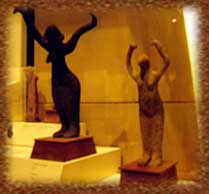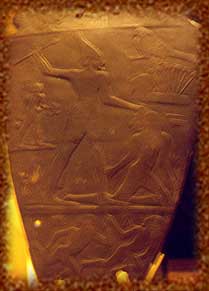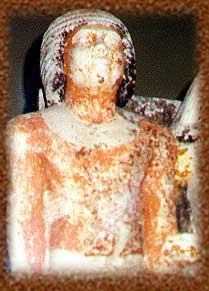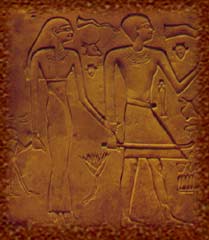| Development
of Ancient Egyptian Art |
Historical
Periods
Indeed,
the uniformity of Egyptian art is quite remarkable. Nevertheless,
each historical period has distinctive traits, whether it
be fashion, hairstyle, the prominence of a specific deity,
innovation, or foreign influence. Art of the major historical
periods is briefly presented here, giving a glimpse into the
rich artistic expressions, creativity and cleverness of the
ancient Egyptians.
Predynastic
Period
Egyptian art of this period flourished in independent cultural
centres in both Upper and Lower Egypt at sites such as Badari,
Naqada, Merimde, and the Fayoum. The artistic expression is
quite primitive - as if it were drawn by a child. Stick men
herding bovines or hunting gazelles. Stick sailors on boats
with numerous oars and a prominent deck cabin. Females standing
with hands above their heads. Yet, the exact meaning of these
simple drawings somewhat eludes us. The composition of the
scenes does not appear to follow strict rules, with an exception
or two. Boats were depicted amongst groups of people hunting,
wrestling with one another or with wild beasts. Were the Egyptians
depicting normal, every day life, a major event, or a funerary
procession on the Nile? Who are the female figures with their
arms raised above their heads?
|
Female Figurines from the Predynastic Period now found
at the Royal Ontario Museum
|

Credits: Caroline Rocheleau |
Along
with drawings painted on tomb walls (such as Tomb 100 at Hierakonpolis)
or ceramic vessels, the ancient Egyptians carved exquisite
ivory combs with zoomorphic handles, ivory anthropomorphic
figurines, and stone palettes. They also made ceramic figurines
and magnificent stone vessels. The zoomorphic motifs, either
painted or sculpted, are comprised of an interesting variety
of animals, reptiles, and birds that are not always equated
with Egypt: giraffes, hippos, ostriches, gazelles and numerous
horned animals, crocodiles, flamingos, fish, iguanas, turtles,
lions, ibis, and dogs. Statuary is developed extremely slowly
and is non-existent at this period.
By late Predynastic period, ancient Egyptian art had incredibly
matured and can be considered as a transition phase into the
Archaic period. Numerous palettes carved in greywacke, a hard
dark grey stone, and decorated with animals, emblems of towns
and forts, as well as fighting scenes seem to allude to a
period of confrontation between groups of people. Possibly
the unification of Upper and Lower Egypt.
Archaic
or Early Dynastic Period
The Archaic period represents the formative stage of the ancient
Egyptian civilisation, as we know it. After the unification
of the Two Lands under the rule of a single king, Egyptian
art was completely transformed. The chaotic aspect of Predynastic
art has been abandoned and replaced by structured compositions.
Artistic conventions that were to control Egyptian art for
the three millennia to come were adopted during this epoch.
The Narmer palette, the most beautifully preserved monument
of the Archaic period, represents King Narmer (Dynasty 0)
grabbing a foe by the top knot and about to smite him with
his mace head. This prototypical representation of the king
would become part of royal iconography until the death of
ancient Egyptian civilisation. It symbolised superiority of
the Egyptian king, who held a divine office and was the beholder
of Maat, cosmic harmony.
|
Facsimile of the Narmer Palette from then Dynasty 0
found at the Royal Ontario Museum
|

Credits: Caroline Rocheleau |
Archaic
art that has survived is comprised mostly of statuettes of
the king wrapped up in a cloak, stelae with the king's name
in a serekh, engravings of the king smiting an enemy as well
as a few statuettes and stelae of nobles and priests.
Old
Kingdom
The epoch also known as the 'age of the pyramids' was an era
of great architectural achievement and unsurpassed aestheticism.
Statuary reached new heights - literally - as artists produced
life size or almost life size statues. Additionally, exquisite
details such as inlaid eyes, together with richly coloured
paint contributed to their beauty and their lifelike impression.
These 'living images' were nevertheless not portraits in the
true sense of the modern word even though artists paid a certain
attention to facial features. These statues, although elegant
and polished, were not intended for public viewing. Private
statues of individuals were destined for tombs and were accessible
only to priests who would bring for them daily offerings and
perform rituals in order to sustain the deceased in the Afterlife.
Royal statues must be considered as an entirely different
category, not only because of their superior craftsmanship,
also because of their intended use. Statues of kings had a
political goal: asseverate the status of the ruler within
society.
Paintings and reliefs, which decorated private tombs with
scenes of every day life, the deceased performing his tasks
and his daily job, family activities, such as hunting and
fowling scenes, as well as funerary and religious scenes,
attained the same quality of execution as statuary. These
scenes ensured the survival (and the pleasure) of the deceased
in the Afterlife; should the priest responsible for the upkeep
of the tomb and the bringing of offerings fail his duties,
the depiction of the deceased sitting at a table garnished
with food and drink would, with a little magic of course,
suffice to nourish him or her.
Royal reliefs and paintings found in temples serve, once again,
a political agenda. Pictures of the king striding forward
as if running were representations of Heb Sed festival (the
30 Year Jubilee of the king's reign) during which the king
ran laps in order to prove to his people that he was strong
and fit to rule. The king could also have been represented
bow and arrows in hand, hunting wild beasts in the desert;
a scene that intimated his skill as a provider for his people,
that demonstrated him as a fearless leader ready to brave
wild beasts to protect his country, but mostly as a king who
sees that Maat, the goddess and the concept of cosmic harmony,
reigns in the Two Lands. There is also the ever-famous smiting
scene where, like on the Narmer palette, the king shows his
superiority over a foe.
|

|
Old
Kingdom statues, as well as paintings and reliefs, depicted
humans as eternally young and beautiful, staring straight
ahead, lost in contemplation. Men were represented at the
height of their physical fitness: large shoulders, flat abdomen,
muscular biceps and legs. They sported short kilts that showed
off the muscles in their thighs and calves. Women were svelte
and gracious, and their narrow hips, flat belly and full firm
breasts were enhanced by the extremely tight sheet dresses
they donned. Most wore wigs, as indicated by a second hairline
on their forehead.
|
Funerary Statue of Kapuptah and his wife Ipep from the
5th Dynasty found at the Kunsthistorische Museum, Vienna
|

Credits: Caroline Rocheleau |
There
is an inherent nobility exuding from Old Kingdom statuary
and reliefs that is somehow absent in the later periods, even
during the New Kingdom.
First
Intermediate Period
The Old Kingdom ended in disunity and chaos; the centralised
power of the king crumbled, a severe drought swept the country,
and a civil war broke out. Needless to say, art suffered immensely.
Royal workshops being closed, artists had no rigorous training
and could only copy Old Kingdom reliefs, paintings and sculptures
to the best of their abilities. Some artists had talents,
others did not. Human figures with disproportionately long
limbs and awkward silhouettes were depicted in curiously rendered
actions and movements. Yet, the art of the First Intermediate
Period has a certain naive charm.
|
Funerary Stelae of Neferher and his wife Senet from
the First Intermediate Period found at the Royal Ontario
Museum
|

Credits: Caroline Rocheleau |
Middle
Kingdom
The Middle Kingdom, referred to as the golden age of ancient
Egyptian literature, generally is forgotten when discussing
Egyptian art. Yet, even though fewer monuments and masterpieces
have survived the passing of time, Middle Kingdom art was
perceived as "classical" art by later generations of Pharaohs.
Artists of the Late Period were so inspired by the Middle
Kingdom that they replicated sculptures and paintings with
such great care that even Egyptologists have difficulty ascribing
an art piece to one of the two epochs!
Although art appears quite eclectic as a result of different
styles adopted during the reign of each king, the royal artists
nonetheless achieved great technical quality in their work
and, more importantly, intense degrees of individualism and
realism. The Egyptians of the Middle Kingdom performed the
same activities that Old Kingdom people did and they painted
those in their tombs. Middle Kingdom kings built impressive
fortresses in Nubia and made sure that the Nubians were aware
of their power by having stelae carved with an image of them
smiting a Nubian enemy. However, the major differences reside
in the different quality of execution, the new expressive
and realistic qualities of the art, and the fashion of the
time.
During the Eleventh Dynasty, art resembled greatly that of
the Old Kingdom, both in artistic rendition and clothing style,
even though the quality is not as excellent. Distinct changes
occurred after the reign of King Amenemhat the First, the
first king of the Twelfth Dynasty. Artistic expression revealed
an increasing tendency towards a more expressive style, with
greater degree of realism. The most striking examples of individualism
date to the reign of King Senwosret the Third, the apex of
Egyptian expressionism, if one can call it that. A magnificent
granite statue in the Egyptian Museum in Cairo presents the
king in the most realistic manner - previously unseen and
never later equalled. Senwosret's surprising melancholic facial
expression is enhanced by the small sunken eyes, sleepy eyelids,
emphasised eyebrow ridges, bags under the eyes, and a downturn
smile. Despite this fatigued expression, ancient Egyptian
texts describe Senwosret the Third as a self-conscious, determined,
and ruthless king.
Also during the Twelfth Dynasty new fashion styles that help
differentiate art from previous and later periods appeared.
Women now wore their hair / wig in the 'Hathor' style: medium
length hair brought over the shoulders and curled at the ends.
Like Old Kingdom women, they wore tight dresses. Men wore
shoulder length wigs that were very thick at the ends quite
different from the short, thin hair of many Old Kingdom men.
They also wore a much longer kilt (mid-calf) that very often
was tied underneath the arms, a bit like a wrap around dress.
Second
Intermediate Period
Little is known of the Second Intermediate Period, a time
when Egypt was ruled by foreign kings, the Hyksos. Much as
yet to come to light before the epoch can truly be understood.
Ongoing excavations at the site of Avaris (the Hyksos capital
city situated in the north-east Delta) have revealed the most
surprising fragments of painted plaster that resemble Minoan
frescoes of the Palace of Knossos in Crete.
New
Kingdom
The New Kingdom was an age of international relations during
which Egypt was a dominant power in the Near East. The Hyksos
invasion had shown the Egyptians their own weakness and had
scarred the common Egyptian psyche. Eighteenth Dynasty pharaohs
(as they can now be called) extended their territory beyond
the borders of Egypt, creating buffer zones to protect their
country from further invasions. Lands as far south as modern
day Sudan and as north as modern day Syria were under Egyptian
domination.
For
the first time in its history, Egypt had an actual standing
army rather than conscripts and a handful of mercenaries.
This new military aspect of ancient Egyptian society had an
interesting impact on art. Temples were decorated with kings'
military expeditions and exploits, and this time they were
doing more than smiting an enemy with a mace head. New Kingdom
pharaohs were represented standing in their chariot, reins
strapped around the waist, shooting arrows and trampling enemies.
Even thought the scene was different, the propagandist message
remained unchanged.
(Caroline
Rocheleau)
|
|